|
|
Installing Your Shock | General Maintenance | Before You Ride | Measuring Sag | Setting Sag | Adjusting Rebound | ProPedal: Dial or Switch | Bottom-Out Resistance | Boost Valve | Service Intervals | Important Safety Information | Stuck Down Shock | Air Sleeve Maintenance | DHX Air Explained
If you are installing your shock on a bike in which the shock is not original equipment:
There may be a small amount of air sleeve lubricant residue on the body. This is normal. If this residual air sleeve lubricant is not present, this is an indication that the air sleeve should be re-lubricated. Some other things to consider for all shock models:
Note: Do not use any solvents or de-greasers, as these products can damage the shock's exterior finish or its anodized parts.
Do not spray water directly on the seal/shock body junction. Do not use a high pressure washer on your shock.
You can also view a Flash video on Setting Sag.
To set sag on your DHX Air 5.0:
Shock Travel | Sag |
2.00/50.8 | .50/12.7 |
2.25/57.2 | .56/14.2 |
2.50/63.5 | .62/15.7 |
3.00/76.2 | .75/19.0 |
Rebound controls the rate at which your shock returns after it has been compressed. The proper rebound setting is a personal preference, and changes with rider weight, riding style and conditions. A rule of thumb is that rebound should be as fast as possible without kicking back and pushing the rider off the saddle.
The rebound dial has approximately 22 clicks of adjustment.
For slower rebound, turn the red adjuster knob clockwise.
For faster rebound, turn the red adjuster knob counterclockwise.
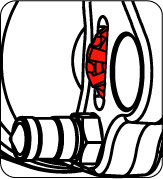
The ProPedal adjustment knob allows the rider to adjust the amount of ProPedal damping. ProPedal damping affects the initial part of the compression stroke and is designed to control pedal-induced suspension bob. Since suspension designs vary, not all bicycles require the same degree of ProPedal damping.
There are 15 clicks of adjustment:
For more ProPedal damping, rotate the ProPedal knob clockwise.
For lighter ProPedal damping, rotate the ProPedal knob (shown below) counterclockwise.
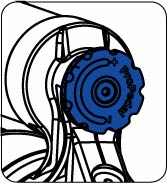
The ProPedal adjustment switch allows the rider to adjust the amount of ProPedal damping using a 2-position switch, which varies from FIRM to SOFT. ProPedal damping affects the initial part of the compression stroke and is designed to control pedal-induced suspension bob.
The switch has two (2) positions:
For more ProPedal damping, rotate the ProPedal switch clockwise.
For lighter ProPedal damping, rotate the ProPedal switch (shown below) counterclockwise.
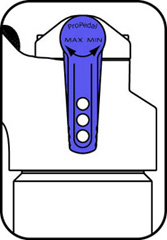
Bottom-out resistance affects the final part of the compression stroke. The knob can be turned with a 4 mm hex key inserted into one of the holes around the perimeter. Do not use any other tool to turn the knob—a 4 mm (or 5/32”) hex key only!
Turn the knob all the way clockwise for the most bottom-out resistance and counter-clockwise for the least. There are three (3) rotations of adjustment and three (3) corresponding adjustment indicator lines on the reservoir.
For more bottom-out resistance, turn the knob clockwise.
For less bottom-out resistance, turn the knob counterclockwise.
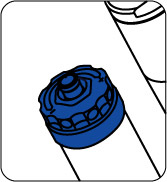
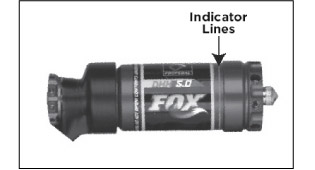
Note: If the knob feels gritty during rotation, set the knob to maximum volume (fully counterclockwise), and then use a 2 mm (or 5/64") hex key to loosen the set screws in the perimeter holes and remove the knob. Clean the knob thoroughly. Lightly grease, then re-install the knob.
The Boost Valve creates a position-sensitive damping scheme that allows for a seamless transition from efficient ProPedal to square-edge bump absorption to a bottomless end-of-stroke feel. The Boost Valve also decouples the ProPedal and bottom-out adjustments, enabling ProPedal platform adjustments to be made without affecting the changes made to the bottom-out adjustment.
The Boost Valve is not adjusted directly. Instead, its behavior and performance characteristics are influenced by the air pressure setting in the reservoir and by adjusting the ProPedal knob.
To change the compression damping characteristics of your DHX Air 5.0 shock, attach a FOX High Pressure Pump to the air valve on the reservoir:
For a firmer ride, add 10 – 15 pounds of air pressure, to a maximum of 200 PSI.
For a softer ride, decrease the shock’s air pressure 10 – 15 pounds by using the pump’s bleed valve, to a minimum of 125 PSI.
Ride your bike and verify the settings before repeating the procedure.
CAUTION: Never ride your bike with more than 200 PSI, or less than 125 PSI in the reservoir air chamber. Doing so can damage your shock and require repairs that are NOT covered under warranty.
Certain aspects of the Boost Valve can influence the ProPedal adjustment.
If the ProPedal adjustment knob is fully counterclockwise (lightest ProPedal damping position) and the compression damping is still too strong, attach a shock pump to the Schrader valve on the reservoir and reduce the pressure 10 – 15 PSI. Repeat to achieve the desired compression damping.
If there is not enough compression damping with the ProPedal knob fully clockwise, add 10 – 15 PSI to the Boost Valve until desired compression damping is achieved.
![]()

Bushing Technology & Inspection | Seals & Foam Rings | Control Direction | Oil Volumes | Structural Inspection | Dropout Thickness Inspection | Torque Values | Unit Conversion | Suspension Tuning Tips | Using the Pump | Important Safety Information | Service Intervals | Contact FOX Service | Warranty Information | FOXHelp Service Web Site
Copyright © 2010
FOX Factory Inc.